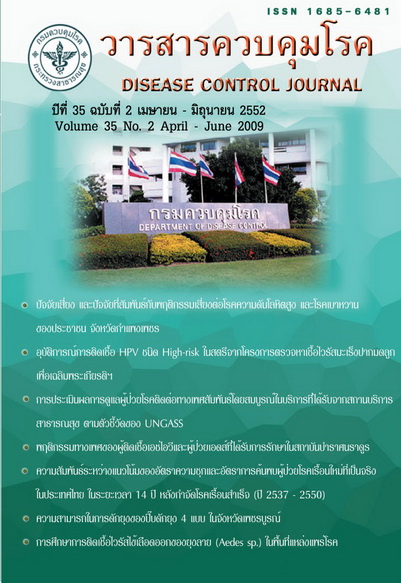Sexual Behaviors of HIV/AIDS Patients in Bamrasnaradura Infectious Diseases Institute
Keywords:
Sexual transmitted diseases, HIV/AIDS, Sexual behaviorsAbstract
The main objectives of this routine to research were to assess HIV/AIDS patients' sexual behaviors who received service at Outpatient of Medicine, Bamrasnaradura Infectious Diseases Institute and to analyze the relationship between their demographic data and sexual behaviors. The study focused on 482 HIV/AIDS patients attending the outpatient of medicine of the Institute. The questionnaires were used to collect data by interviewed patients at the routine service. The result showed that 77.1% of HIV/AIDS patients had HIV infected by unsafe sex. Their mean CD4 was 356 cells/mm3. Most of them had CD4 > 350 cells/mm3 (46.3%) and had Viral Load < 50 Copies/mm3 (87.8%). About 59.5% of HIV/AIDS patients were sexually active. In term of family planning method, it was found that 73.4% of them used only one method, of which 77.1% use condom and 13.3% were sterilized. In addition, the condom use rate at last sexual intercourse was 90.2% with causal partner, 85.1% with steady partner and 80.8% with sex workers. However, There was significantly relationship between using condom and disclosure their HIV status at Pvalue 0.028. The study found many factors that caused prevention of HIV transmission including HIV disclosure, patients' awareness of prevention of HIV transmitted and system of service. Therefore, the health care setting needs to improve the quality of services such screening for risk behaviors, promote condom usage, HIV disclosure, and enhancing drug adherence. Family planning counseling was the other aspect which needed to be strengthened in order to prevent mother to child transmission of HIV/AIDS. The most important of prevention HIV transmission was how to empower PLHA awareness of self esteem and self care by themselves.
Downloads
References
2. กลุ่มโรคเอดส์ สำนักโรคเอดส์ วัณโรคและโรคติดต่อทางเพศสัมพันธ์, วิเคราะห์สถานการณ์โรคเอดส์ในประเทศไทย. อ้างอิงจาก http://www.aidsthai.org/main.php.13ธ.ค.2551
3. สถาบันบำราศนราดูร. รายงานประจำปี 2550.
4. UNGASS country progress report, Thailand: reporting period January 2006-December 2007, Available at http://data.unaids.org/pub/Report/2008/Thailand 2008 country progress report en.pdf, (Accessed Sep 2, 2008)
5. The projection of new HIV infections in Thailand by Risk Group Per Year (East West Center) 2006. (Accessed Sep 2, 2008)
6. สุวิมล ควงสมัย และจุฒาภรณี ประเสริฐถาวรสิริ. พฤติกรรมทางเพศของผู้ป่วยเอดส์ที่รับยาต้านไวรัส. อ้างอิงจาก http://gotoknow.org/blog/community2nurse/63819 31ธ.ค.2551
7. Rojanpithayakorn W and Hanenberg R. The 100% condom program in Thailand [editorial] available at http://www.popline.org/docs/1130/110727.html (Accessed Sep 2, 2008)
8. บังอร เทพเทียน, ปิยฉัตร ตระกูลวงษ์, ปรินดา ตาสี, สุภัทรา อินทร์ไพบูลย์. การเฝ้าระวังพฤติกรรมทางเพศที่สัมพันธ์กับการติดเชื้อเอชไอวี ในพื้นที่กรุงเทพมหานคร ปี 2549: วารสารสาธารณสุขและการพัฒนา 2550 ปีที่ 5 ฉบับที่ 1
9. Centers for Disease Control. Recommendations of preventing transmission of infectious with human T-lymphotropic virus type III/lymphadenopathy-associated virus in the workplace MMWR 34 (1985): 681-686, 691-695.
Downloads
Published
How to Cite
Issue
Section
License
Articles published in the Disease Control Journal are considered as academic work, research or analysis of the personal opinion of the authors, not the opinion of the Thailand Department of Disease Control or editorial team. The authors must be responsible for their articles.


.png)



